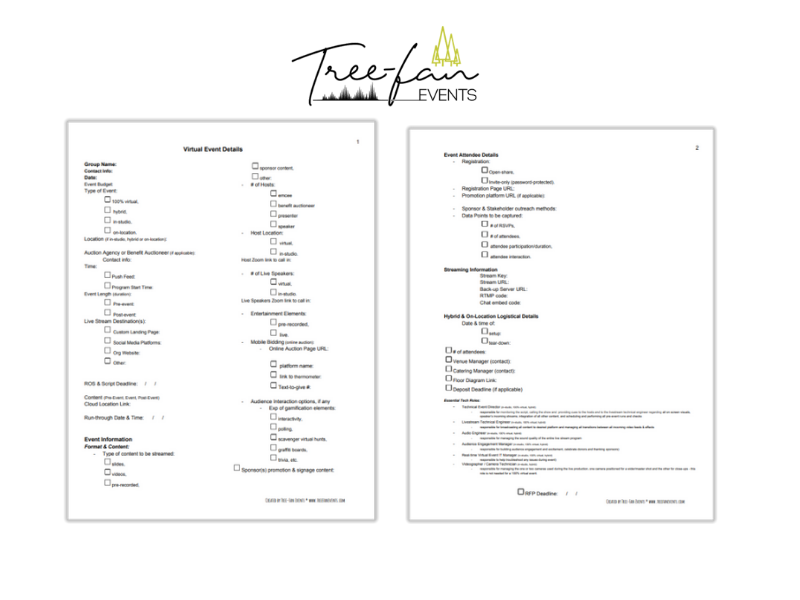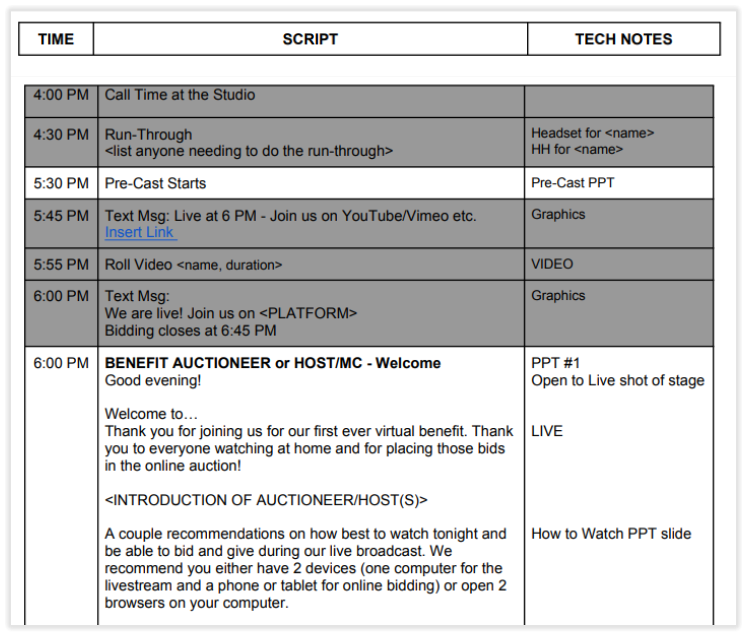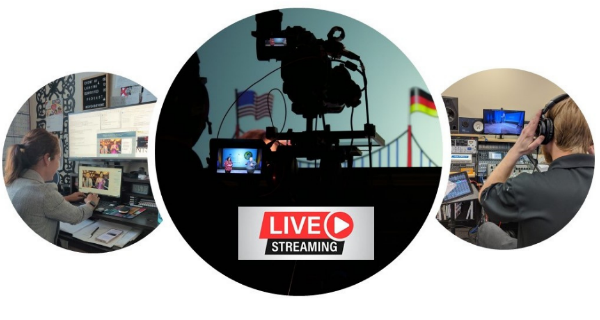Auction and event fundraisers have the opportunity to present as virtual events. Your charity mission is always the headliner. Pairing the fundraiser with a virtual event, gala, home party and even live concerts make these even more unique and memorable. Anca Trifan from Tree-Fan Events breaks it all down for us here. She offers her candid advice and some documents to help map a successful and stress-free virtual fundraising event. In addition to the excerpted documents, the full templates and other guidance can be found on the Tree-Fan website Virtual Event FREE Resources & Special Live-Streaming Information for Auctria Users | Tree-Fan Events
At an in-person event, you have the opportunity to impact all five senses of the participant. Lighting and decorations, foods both smell and taste, music, ambiance, table friends for live interaction. Now with the events going virtual, this is reduced to two senses- sight and sound, it is imperative that both are as close to perfect as possible.
The virtual event can be a casual social event to a professional production, there is lots of room in between. Deciding on how imaginative and complex will dictate the pieces people and the pieces you will need to build the virtual event.
Virtual event capabilities are quite varied. A few questions to ask yourself and the fundraising team:
- Will this be a social event, requiring face to face video screen availability or scaled-down with just a chat function
- Will this be one major event or will there be pre-parties, breakout rooms, VIP invite areas
- Where do you want to broadcast to? Private or public?
- How much will be live, how much pre-recorded?
- How much time will the fundraiser potion of the event consume?
- What talent do you have onboard already or need to seek out? This is in terms of content and technology.
Bottom line do you want to put on a fully produced almost televised show or something more scaled back.
Outlined here are the options of most frequently used pieces we have observed in successful event fundraisers:
- Tools & technology
- CALL, Camera, Audio, Lighting, and Location
- Connections, lighting, and sound
- Run of Show document
- Virtual Event Script & Tech Notes document
Tools and Technology
Don’t let the tools and technology guide the way, let the virtual plan unfold then choose the tech that helps you meet that goal. This decision is made a little easier once you map out the level of sophistication that you are seeking. Then start looking at platforms or professionals that help you reach that goal. Sometimes the pros will use a platform that is available to you as a beginner however in the right hands elevates the usage.
For instance, Streamyard is probably the most simple streaming/ compositing platform available. In the hands of a professional, they can really make it special by helping with branding, overlays, countdown clocks, and multiple streams from many locations or screens.
Where are your supporters going to watch the virtual presentation? Most frequently this answer is the event landing page, or Facebook, YouTube, even Twitch, or for a smaller more sociable experience Zoom. These are environments that are familiar with. Avoiding the questions “Where do I watch? How do I watch it?”, the quicker they can click to view the better!
Some of the DIY Software Favorites being used for virtual events:
Streamyard
StreamYard is a live streaming studio in your browser. Interview guests, share your screen, and much more. Stream directly to Facebook, YouTube, LinkedIn, and other platforms. StreamYard Best for quick and easy set-up from any desktop. Overlays, add text, pull up comments from the live feed. Video upload is limited however can share a video on a screen. Streamyard is easy to learn and easy to learn but is limited.
Open Broadcast Software
OBS for short- OBS Free and open-source software for video recording and live streaming. Download and start streaming quickly and easily on Windows, Mac or Linux. OBS is a software program that you download to your computer. Cool feature: much more control over adding streams and longer video. Many more options however do take time to learn.
Ecamm
Ecamm turns your MAC into a live production studio for broadcasting to Facebook Live, YouTube, Twitch, and Periscope. Cool feature: plug in a mobile device and share your phone screen
Anca’s advice “Use a broadband connection that is hardwired when live-streaming.”
CALL
Camera, audio, lighting, and location are the key factors to high quality, highly polished virtual event broadcast. Hardware favorites for broadcasting like a pro are a good camera with a tripod, good lighting, high-quality microphone. Poor audio quality is going to drive away viewers. If they cannot hear well that is an instant turn-off.
Camera: an HD camera is ideal. If you don't have access to an actual HD video camera, a built-in computer/laptop camera, smartphone camera, USB camera could be used as well. If you reusing your smartphone's camera, using a tripod is recommended to keep the image stable.
Make sure the orientation of the video is in landscape more (no vertical Instagram stories portrait mode-kind of videos please).
Anca’s advice “Also, stay away from Snapchat-like filters and the zoom function on your phone. Position yourself relevant to the camera position without using the digital zoom function which reduces the quality of your video's resolution.”
Audio: When it comes to audio, poor audio is not acceptable. People tolerate a lower resolution video of you than a high-quality HD video with intelligible sound. If you don't have a USB podcast microphone you can easily connect to your laptop, consider buying a lavalier microphone that connects either to your laptop or to your smartphone device. The goal is to pick up the presenter’s voice clearly, without all the background noise that is usually present when not having a close-up microphone.
Anca’s advice “In any TV production, audio always takes priority and virtual events are no different.”
Lighting: the very best lighting is natural lighting. We know this is not possible at all times, especially with virtual events replacing evening functions. Lighting should be evaluated in advance of rehearsals. Examine how the subject matter or speakers are illuminated during the SAME time of day that the event is taking place. Adjust with any light source you have handy like household lamps and overhead lights. Alter the brightness, height, angle, and distance from the speaker. After you do get the lighting exactly how you want to take notes and pictures of the set-up so you can re-create the lighting when needed.
Anca’s advice “Ring-shaped lights have become wildly popular, test these too though. If too close they create a ring reflection in the speaker’s eye that can be distracting.”
Location: be aware of the background. Simple backgrounds are best. If it's cluttered, consider moving your setup to a more minimalist location or if that’s an option, invest in a photography green screen backdrop.
Anca’s advice “Clothing choices should be intentional but most importantly, to make you feel confident in your skin.”
Professional Virtual Event Producer
The professionals may use the same programs however with their experience can provide a much more polished production. They do so with graphics, overlays, b-roll, and content management. The Virtual Event Producer should be brought in early to work on any of the creative assets and map out the entire planning and implementation of the virtual event. The event producer should use a few outlines to ensure no details are missed. This starts with the Virtual Events Details document.
Virtual Event Details
This keeps everyone on the same page. This outline that you may want to use when seeking information and pricing from a Virtual Event Producer. Continue to update and use this document to stay on track for both time and budget. Here is an example of the details you should be collecting and provided to the virtual event team.

Run of Show
The run of show will be minute-by-minute documentation outlining times, who is speaking, and what they are covering during that time. For a virtual fundraising event that runs 45 minutes it may look something like this:
- 5:30 PM: 30 Minute Pre-Cast: Instructions on how to join us live at, register as a bidder, and any image slides deck
- 6:00 PM Go Live: Welcome by host/MC Theme: – build excitement for all those tuning in Verbal instructions on how to participate from home for bidding and giving (banner overlay) Introduce incentive to register: Each registered bidder will be entered to a win prize, etc (TBD)
- 6:05 PM MC introduces In-studio: remarks on current climate, we’ll all gather together again soon, emphasizing the importance of community and how the community is adapting in this climate.
- 6:08 PM Benefit Auctioneer or Host/MC transitions to recognize sponsors Pre-recorded: Messages from sponsors Benefit Auctioneer or Host/MC transitions to celebrate viewers and supporters Live Stream Chat: use platform to recognize messages as they come
- 6:12 Promotion for online auction, announce current bids and celebrate winners
- 6:14 (Live #1-5) Benefit Auctioneer or Host/MC introduces video –
- 6:35 PM Pre-recorded: Speaker video plays – (exp 2 min)
- 6:37 PM Virtual Appeal Benefit Auctioneer facilitates with predetermined levels of giving using Auctria online platform Leaderboard to recognize gifts as they come in
- 6:42 PM Benefit Auctioneer transitions and celebrates community Pre-recorded: Video message – (exp 2 min) Promote give now, online auction, announce current bids and celebrate winners (Live #6-10)
- 6:45 PM Host/MC closes, roll credits/sponsor/donor list
Virtual Event Script & Tech Notes
The purpose of this document is to track the production tasks alongside the run of show. This includes any and all links for Livestream and outlines any supplemental production elements that need to be opened and organized prior to going live. Include link, logins, folders, content, and asset locations.
Include on the Event and Tech notes instructions for when parties need to arrive online. Ideally, that would be an hour prior to the event beginning. This gives ample opportunity to do a final rehearsal, soundcheck, connectivity check.
The event script and tech notes are best displayed on a simple table that had three headings: Time, Script and Tech Notes. The more detailed and specific the document the more reliable it will be when you need to use it as a reference. Here is an example of a few lines of what a professional would produce.

Calling in the Professional Virtual Event Producer
The auction team that is pivoting to virtual us using a hybrid in the future may not have the skills, time, or equipment to make the virtual event shine, as technology offers some creative solutions to virtual event challenges, and that’s ok. The benefit of hiring an event producer and production live-streaming to produce your event is the overall polished product that you can take advantage not just during the live broadcast of the event, but afterward too. Elements such as supportive graphics, overlays, picture in picture, smooth transitions between slides and videoclips, licensed music, and other elements, not to mention the insurance of knowing that run-through rehearsals are taking places, and retakes or editing are available as well so that you can really polish your event, just like a TV show that’s broadcasted live this day really is. Before the event goes live, The VEP and the technical live streaming team will run a Cue2Cue run-through and make sure all event elements are included in the build of the live-stream.
For in-person events, event design was carefully curated from the moment that attendees walked through the doors of your venue, with help desks, volunteers to answer any question, complimentary transportation.
For virtual events, the touchpoints of their roadmap have to be just as carefully considered, even as now we’re not dealing with linens, centerpieces, background music, mood-changing lighting and event staff that can easily answer any question the attendee might have.
The Producer will help brand and stay on message for the entirety of the event. Using overlays, bottom thirds, chyrons, and transitions your organization will be front and center during the entire event.
The virtual event will be about 45 minutes however it will leave a lasting impression. An exceptional virtual event that is recorded can continue to live on past the initial airing. With this purpose, you may want to elevate the production excellence and use the experts. Production teams are highly trained and will be much more efficient in running a virtual event. They will also coach you based on their experiences. In creating a highly polished event, the reflection back is on your charity, mission, and cause.
A recent virtual event produced by Tree-Fan was for the Evergreen Aviation and Space Museum. They are focused on becoming a world-class center for innovation, preservation, education, and inspiration. The virtual event was the perfect mix of innovation and history to drive support and intrigue. Click for a replay of the virtual event.
Special thanks to Tree-Fans founder, Anca Trifan for sharing her expert advice. Click here to get a complete package of virtual event templates including:
- Virtual Event Script & Tech Notes
- Run of Show
- CALL Tips
- Virtual Event Checklist
Podcast: Events: demystified Auctria was episode #19 and there are many that are directly related to charity and fundraising events.
YouTube: Tech Tuesday On the Tree-Fan YouTube channel you will find a Tech Tuesday playlist. Here Anca discusses and answers all your virtual event tech questions.
